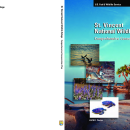Management and Conservation
Refuge Managed Impoundment System Management
The Refuge actively manages nearly 200 acres of open water on St. Vincent Island. The six permanent open water bodies are managed as three separate impoundment systems for a variety of fish and wildlife resources. The depths and salinities of the three impoundment systems vary seasonally according to monthly targets and local precipitation but function together to provide habitat conditions for nesting wading birds, food communities for a wide variety of migratory waterfowl and other water-birds, fresh water for island wildlife, and a viable and popular freshwater sport fishery.
Exotic Plant Eradication Program
Refuge staff and volunteers work to identify and remove a wide variety of nonnative plants from the Refuge to benefit native fish and wildlife species. Exotic plants such as the Chinese tallow tree (also known as the popcorn tree) are removed with a combination of control methods including prescribed fire, physical or mechanical means, and herbicide application.
Endangered Species Program
- Marine turtle nesting survey
- Shorebird habitat management
- Red wolf island propagation program
Wildlife Population Management
- Wood Duck nest box maintenance
- Wading bird rookery monitoring
- Breeding bird surveys
- Deer herd management
Fire Management
Fire -- Beneficial to Wildlife and People
Fire is a natural part of North American ecosystems. Here on St. Vincent National Wildlife Refuge, fire is ignited in two different ways. The first way is unplanned fires ignited by lightning. These unplanned fires are called wildfires. The second way is planned fires ignited by the Refuge fire staff called prescribed fires.
Wildfires
Before St. Vincent NWR was altered with roads, lightning would ignite a fire that could burn throughout the various habitats. Now when lightning starts a fire, the refuge fire staff decides where to stop the wildfire. We use tactics that minimize damage to the hydrology of the island. These tactics may include using water, building control lines or using a controlled fire called a back fire against the wildfire.
Prescribed Fires
Since the island has been changed by human activity, planned fires called prescribed fires or controlled burns are ignited by fire staff to mimic the lightning caused fires. Mimicking the lightning fires with prescribed fires achieves the same results as the naturally occurring wildfires. Fire reduces the amount of live and dead vegetation of flammable fire-dependent plants, which reduces the potential damage of a wildfire.
Diversity of Habitat
Fire recycles nutrients contained in vegetation and opens up the ground cover to bare mineral soil, so that the plant seeds can have space to germinate. Fire promotes plant diversity in the habitat, which offers a range of food sources for the animals that live on or migrate through St. Vincent National Wildlife Refuge.
Gopher tortoises, one of the many animals living on St. Vincent NWR, rely on fire to keep their habitat suitable. Without fire, the woody plants and saw palmetto grow very tall and thick. Little sunlight can reach the ground. The herbaceous plants that are the primary food source for the gopher tortoises do not grow in the shade. Frequent fire keeps the woody plants, including saw palmetto short and sparse, so that the herbaceous plants continue to flourish for the gopher tortoises to eat.
Relatively frequent fires benefit native wetland animals as well. Well timed prescribed fires help salt marsh salt marsh
Salt marshes are found in tidal areas near the coast, where freshwater mixes with saltwater.
Learn more about salt marsh species like the Seaside Sparrow to thrive. These sparrows require a mosaic of sparse and dense herbaceous vegetation for nesting. Lack of fire allows woody vegetation to invade marshes, making them unsuitable for Seaside Sparrow nesting. To keep the marshes open, the fire management staff burns the marshes frequently, approximately every other year.


